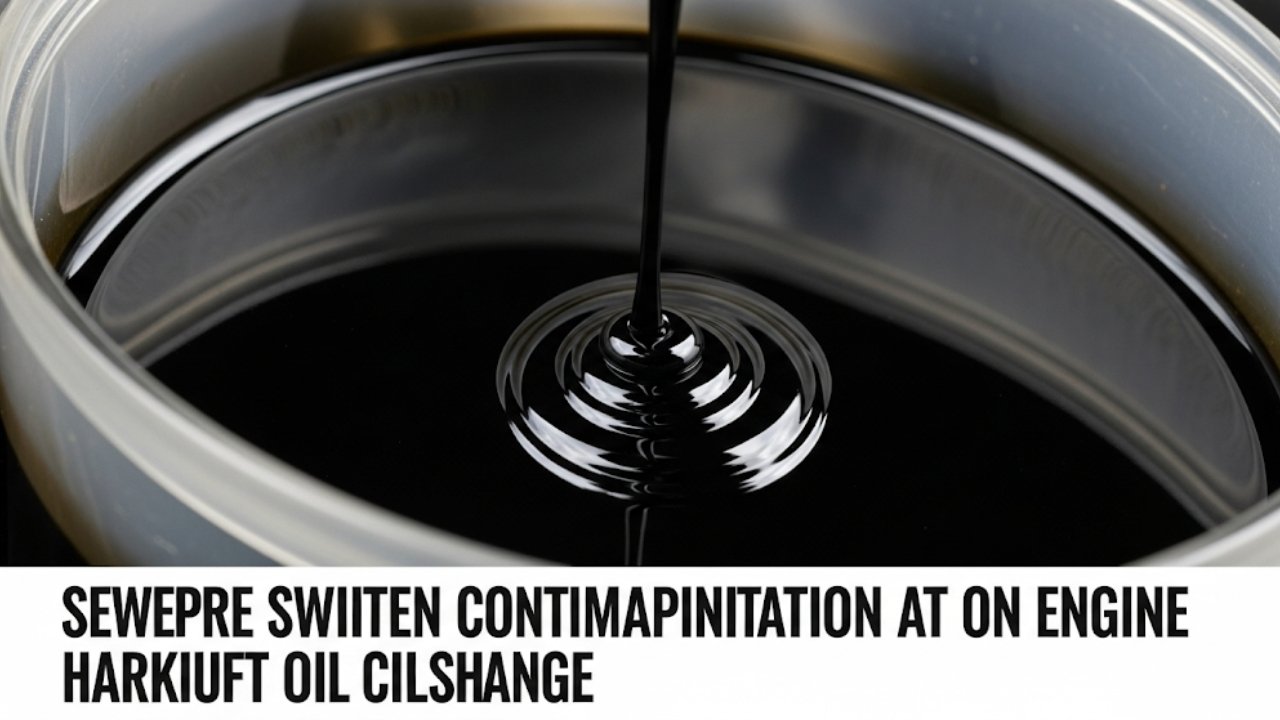Bad Car Oil Color: What It Really Means

Let me ask you something: when was the last time you checked your engine oil and paid close attention to the color? If you’re like most drivers, probably never—or at best, once or twice a year during an oil change. But here’s the thing: the color of your car oil says more than you might think. And spotting a bad car oil color can literally save your engine from breaking down on the highway in the middle of nowhere.
I’ll be honest—I didn’t always pay attention either. I used to think, “Oil is oil. As long as it’s in there, I’m good, right?” Wrong. Very wrong. Ignoring the signs cost me a weekend road trip, a tow truck bill, and a hefty repair at the local garage.
This article will walk you through everything I’ve learned (both the easy and hard way) about bad car oil color, what it tells you, and what to do about it. You don’t have to be a mechanic to spot a problem. All you need is a paper towel, your dipstick, and some honest curiosity.
Let’s dive in.
What Does Car Oil Color Tell You?

When oil is new, it looks golden or amber. Think of warm honey or fresh-brewed tea. But as it ages and absorbs particles, it gets darker. Sometimes it turns black, brown, milky, or even gray. Each shade has its own meaning, and knowing what bad car oil color looks like can help you spot trouble before it turns expensive.
Just like bruises on a banana or the cloudiness in a cup of water, oil color changes because of what’s happening inside the engine. So, instead of ignoring it or waiting for the check engine light to flash, learn to read the signs yourself.
Why Fresh Oil Looks Different from Old Oil
Fresh engine oil is light, clear, and easy to pour. It has a syrupy texture and often smells slightly sweet or neutral. It’s designed to flow easily and coat every moving part without leaving a mess behind.
But after a few thousand kilometers, everything changes. The heat of the engine “cooks” the oil, breaking it down slowly. Dirt from combustion and metal particles from moving parts get mixed in. If you’ve ever worked in a kitchen, it’s like reusing the same frying oil over and over—it gets darker, dirtier, and way less effective.
Eventually, the oil thickens, darkens, and might even start to smell burnt. When this happens, it’s no longer protecting your engine the way it should. And that’s exactly why spotting bad car oil color early can help you avoid bigger issues.
Here’s a little analogy: Would you keep brushing your teeth with a blackened toothbrush covered in grime? No way. Then don’t let your engine run on dirty oil.
Understanding What a Bad Car Oil Color Looks Like
So, what exactly is a bad car oil color? It’s not just “dirty” oil. It’s oil that’s telling you something is wrong—or about to be.
Here’s a simple rule of thumb: The darker and more unusual the color, the more serious the problem might be.
Now, oil naturally darkens over time, especially in diesel engines or older cars. That’s normal. But if your oil changes color too quickly, or takes on strange tones like milky white, muddy brown, or gritty gray, it’s time to dig deeper.
Think of it like your coffee. Freshly brewed, it’s dark but smooth. Leave it sitting too long and it gets cloudy, cold, and stale. Oil is the same. If your dipstick pulls up something that doesn’t look right, your engine might be trying to tell you something important.
Common Bad Oil Colors and What They Mean
Let’s break down the different oil colors and what they could mean for your car. Here’s a quick reference table:
| Oil Color | What It Looks Like | What It Might Mean |
|---|---|---|
| Amber/Light Gold | Clear, honey-like | Fresh oil, perfectly fine |
| Dark Brown/Black | Thick but smooth | Normal if not too old; needs change soon |
| Milky or Creamy | Coffee with milk look | Possible coolant leak—dangerous |
| Foamy or Bubbly | Bubbles in the oil | Moisture contamination or overfilled oil |
| Gray or Silver | Metallic shine | Metal shavings—engine wear or damage |
| Gritty or Sludgy | Chunky, sludge-like texture | Neglected oil—could lead to engine failure |
| Reddish (in some cars) | Slight red tint | Could be transmission fluid contamination (rare but serious) |
Each of these oil colors is like a symptom in your body. A cough could mean a cold—or something more serious. Same with your car’s oil. When in doubt, ask a mechanic or get a professional oil analysis.
Personal Story: The Time I Ignored Dirty Oil—and Paid for It
I once owned a silver Honda Civic. She was a champ—took me across cities and countryside without complaint. But I was a lazy car owner. Oil change? I’ll do it next month, I’d say. That month turned into three, and by the time I remembered, my dipstick pulled up sludge-black oil that smelled like burnt toast.
I shrugged it off. The car still ran, right? Until one morning, on a weekend trip to Cox’s Bazar, the engine started rattling. Then came the overheating. We had to pull over near a remote tea stall, miles from the nearest workshop.
The mechanic later said the oil was so thick it wasn’t reaching the engine top. I had to replace the oil pump, flush the engine, and replace gaskets. All because I didn’t take bad car oil color seriously.
Moral of the story? Don’t be like me. Your engine gives you early warnings. Learn to spot them.
How Often Should You Check Car Oil Color?
Let’s be honest—most of us forget to check our oil until it’s too late. But here’s the deal: checking your car oil color regularly isn’t just for car nerds. It’s something every driver should do, even if you don’t know a spark plug from a seatbelt.
As a general rule, you should check your oil every two weeks or at least once a month. If you drive long distances, have an older car, or live in a place with extreme heat (hello, Dhaka summers), check it more often.
Don’t wait for the oil change light or the engine to start groaning. A 2-minute check could save you from thousands in engine repairs. All you need is:
-
A clean rag or tissue
-
A flat surface (your driveway or garage)
-
Your car’s dipstick
Trust me—after you make it a habit, it becomes second nature, like brushing your teeth. And just like teeth, neglect leads to decay.
How to Check Oil Color Properly (Step-by-Step)
If you’ve never done this before, don’t worry. I’ll walk you through it like I would with a friend who’s doing it for the first time.
Step-by-Step Guide:
-
Park on a level surface and turn the engine off. Wait 5–10 minutes to let the oil settle.
-
Open the hood and find the dipstick—usually a yellow or orange loop.
-
Pull out the dipstick and wipe it clean with a rag.
-
Insert it back fully, then pull it out again to check both the level and color.
-
Inspect the oil under good light:
-
Is it amber or light brown? ✅ You’re good.
-
Is it dark, thick, gritty, or milky? ❌ That’s a bad car oil color.
-
-
Smell the oil (yes, seriously). If it smells burnt or gassy, something’s off.
Pro Tip:
Hold the dipstick over a white napkin or paper towel. The true color of the oil shows better this way.
Remember: it’s not just about how much oil you have—it’s about how healthy it is. A car can have a full oil tank and still be in danger if the oil is contaminated.
Why Ignoring Bad Oil Color Can Be a Costly Mistake
Here’s something that doesn’t get said enough: Ignoring your car’s oil condition is like ignoring chest pain and hoping it goes away. It might. But the risk is too high.
Engines depend on oil for lubrication. Once the oil loses its clarity and turns dark, foamy, or gritty, it can no longer protect moving parts. That leads to:
-
Metal-on-metal contact
-
Increased engine heat
-
Sludge buildup
-
Oil starvation
-
Total engine failure
And replacing an engine? That can cost you more than your entire car is worth. Ask anyone who’s had to deal with a seized engine. It’s a nightmare.
All this from ignoring what started as bad car oil color.
FAQs About Bad Car Oil Color
Let’s clear up some common questions drivers ask:
1. Is dark brown or black oil always bad?
Not always. Oil naturally darkens as it does its job. If it’s still smooth and doesn’t smell burnt, you’re probably fine—but it may be nearing time for a change.
2. What does milky oil mean?
This usually means coolant has leaked into your oil, often due to a blown head gasket. This is serious. Get your car checked ASAP.
3. Can oil turn bad even if I don’t drive much?
Yes! Oil degrades over time, even if your car sits still. If it’s been 6 months or longer, inspect it.
4. What if I see metal flakes in my oil?
That’s a major red flag. Metal particles could mean engine wear or internal damage. Don’t delay—visit a mechanic immediately.
5. Can synthetic oil still go bad?
Absolutely. While synthetic oil lasts longer, it still breaks down under high heat or heavy use. Don’t assume it’s immune to bad car oil color.
6. What’s the difference between transmission fluid and engine oil color?
Transmission fluid is usually red or pink. If your engine oil has a reddish tint, you might have a serious leak or cross-contamination.
7. Is foamy oil always a problem?
Foam usually means moisture contamination or an overfill. Either way, it reduces lubrication and needs immediate attention.
8. Can I fix bad oil with an additive or flush?
Oil additives may help temporarily, but they’re not a cure. If your oil is contaminated, it needs to be changed, not masked.
Final Thoughts: Trust Your Dipstick—It Never Lies
Here’s my bottom line: when it comes to your car, the dipstick is your best friend. It gives you a real-time look at your engine’s health—without fancy tools or expensive diagnostics. All you have to do is check it, notice the bad car oil color if it’s there, and act before it’s too late.
I’ve learned this lesson the hard way, but you don’t have to. Listen to your engine. Look at your oil. And remember: if it smells off, looks off, or feels off—it probably is off.
The next time you pop the hood, take a second to pull out that dipstick and really look at the oil. That tiny habit could save you thousands.






